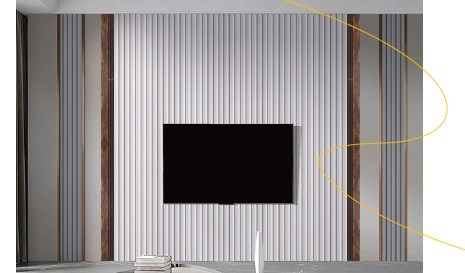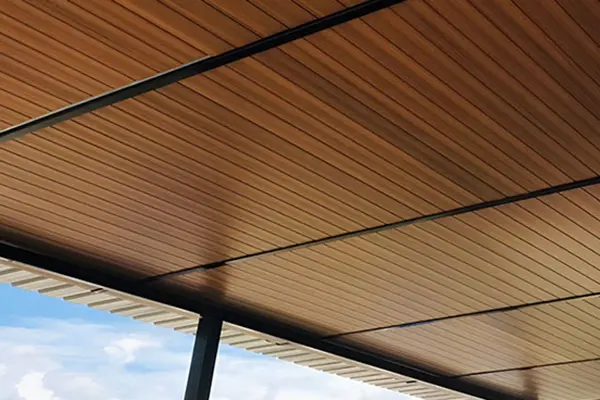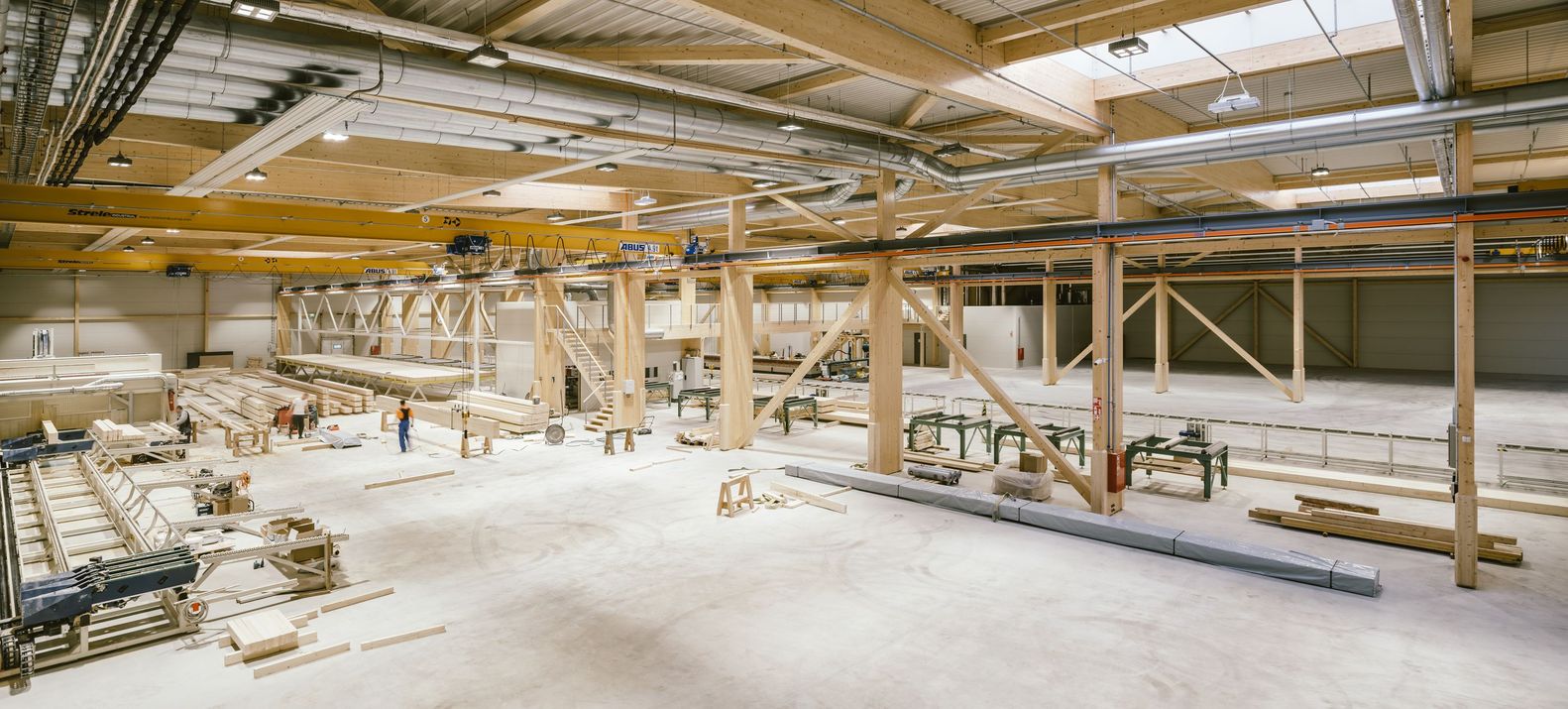CATEGORIES
The Complete Guide to WPC Ceiling Panel: Everything You Need to Know
This article explores the world of WPC ceiling panels, a revolutionary ceiling material gaining immense popularity in the construction and interior design industries. We'll delve into what makes them a superior choice compared to traditional materials, focusing on their composition, benefits, installation, and diverse applications. If you're a construction company owner, interior designer, architect, home improvement retailer, or real estate developer looking for a cost-effective, high-quality, and aesthetically pleasing ceiling solution, this guide is for you.
1. What is a WPC Ceiling Panel?
WPC ceiling panel stands for Wood-Plastic Composite ceiling panel. It's a hybrid material, a new composite material made from a blend of wood fibers and recyclable plastics (often PVC). This unique composition gives it the best of both worlds: the natural look and feel of wood combined with the durability and water resistance of plastic. Imagine having the beauty of wood in your living area, without the worry of rot or termite damage!
WPC wall and ceiling panels are rapidly becoming the preferred choice for both residential and commercial applications. They offer a modern, stylish, and sustainable alternative to traditional ceiling options. This decorative material brings a touch of elegance while providing a strong and durable solution for your ceiling needs. This type of ceiling material is changing the world of interior design.
2. How are WPC Ceiling Panels Made?
The manufacturing process of WPC ceilings involves a precise blend of finely ground wood fibers and thermoplastic materials, such as PVC. The creation of a WPC material is a meticulous undertaking. These components are mixed together under high heat and pressure, creating a homogeneous mixture. This mixture is then extruded or molded into the desired panel shapes and sizes.
The resulting wood-plastic composite (WPC material) is a dense, rigid, and remarkably stable material. Some manufacturers may add a composite surface layer for enhanced durability and aesthetic appeal. This process ensures that the panels are available in a consistent quality, free from the defects sometimes found in traditional wood. The process creates a product that can last a long time.
3. What are the Key Advantages of WPC Ceiling Panels?
WPC ceiling panels offer a multitude of advantages over traditional ceiling materials, making them an increasingly popular choice for both residential and commercial projects. Here's a breakdown of the key benefits:
- Durability: WPC ceilings are exceptionally durable and resistant to moisture, rot, insects, and warping. Unlike solid wood, they are less likely to absorb water, making them suitable for areas prone to humidity.
- Low Maintenance: WPC ceilings don’t require painting, staining, or sealing, unlike traditional wood. Ceiling panels don’t require much maintenance. This translates to significant time and cost savings over the lifespan of the ceiling.
- Easy Installation: WPC ceiling panels are designed for easy to install, often featuring interlocking systems that simplify the installation process. This makes them suitable for both professional installers and DIY enthusiasts. A DIY installation is possible with the installation instructions provided.
- Aesthetics: WPC panels are available in a wide range of colors, textures, and finishes, mimicking the look of real wood or offering contemporary designs. This versatility allows for seamless integration into various interior design styles.
- Cost-Effectiveness: While the initial cost of WPC ceilings might be slightly higher than some traditional options, their long-term durability and low maintenance requirements make them a cost-effective choice in the long run.
4. Are WPC Ceilings Environmentally Friendly?
Yes, WPC ceilings are considered an environmentally friendly option, especially when compared to ceilings made only from solid wood. Here's why:
- Recycled Materials: WPC material is often made from wood fibers and recyclable plastics, reducing the demand for virgin timber and diverting plastic waste from landfills.
- Reduced Deforestation: By utilizing wood waste and recycled materials, WPC ceilings contribute to reducing deforestation and promoting sustainable forestry practices.
- Long Lifespan: The durability of WPC ceiling panels means they have a longer lifespan than many traditional materials, reducing the need for frequent replacements and minimizing waste.

5. What are the Aesthetic Benefits of Using WPC for Ceilings?
Aesthetics is a major factor driving the popularity of WPC ceilings. They offer a sophisticated and versatile way to enhance the visual appeal of any space.
- Natural Look: Many WPC ceiling panels are designed to realistically mimic the natural look of wood, offering the warmth and elegance of timber without the associated drawbacks. These products have the wood with the durability of plastic.
- Wide Range of Design Options: WPC panels are available in a wide range of colors, textures, and finishes, from classic wood grains to modern, sleek designs. Ceiling panels come in many styles. This variety allows for extensive customization to suit any interior design style.
- Concealed Fasteners: The interlocking design of many WPC ceiling panels allows for concealed fasteners, creating a clean, seamless look without visible screws or nails.
6. How Easy is it to Install WPC Ceiling Panels?
One of the significant advantages of WPC ceiling panels is their ease of installation. Many systems feature interlocking designs, like tongue and groove, which allow the panels to snap together securely. This greatly simplifies the installation process, making it faster and less labor-intensive.
For a typical installation, you'll need basic tools like a saw, measuring tape, level, and adhesive or fasteners (depending on the specific panel system). While professional installation is always an option, many WPC ceiling panel systems are designed for DIY installation, making them a popular choice for homeowners looking to undertake renovation projects.
7. How Do WPC Ceiling Panels Compare to Traditional Wood Ceilings?
Here's a table comparing WPC ceilings and traditional wood ceilings:
| Feature | WPC Ceiling Panel | Traditional Wood Ceiling |
|---|---|---|
| Material | Wood-plastic composite | Solid wood, Plywood |
| Durability | High (resistant to moisture, rot) | Lower (susceptible to moisture, rot) |
| Maintenance | Low maintenance | High (requires regular maintenance) |
| Installation | Easy (often interlocking) | More complex |
| Aesthetics | Variety of styles, natural look | Natural wood look |
| Cost | Initially higher, long-term savings | Lower initial cost, higher upkeep |
| Environmental Impact | Environmentally friendly | Can contribute to deforestation |
Choosing WPC interior ceilings eliminates the common issues associated with wood ceilings, such as warping, cracking, and insect infestation. This makes wood plastic ceilings a superior long-term investment.
8. What are the Maintenance Requirements for WPC Ceilings?
WPC ceilings are renowned for their low maintenance requirements. Unlike traditional wood, which often needs regular staining, sealing, or painting, WPC ceiling panels require minimal upkeep.
Regular cleaning with a damp cloth or mild detergent is usually sufficient to keep them looking their best. Their resistance to moisture and staining makes them incredibly easy to care for, saving you significant time and effort in the long run.
9. Where Can WPC Ceilings Be Used?
The versatility of WPC ceilings makes them suitable for a wide range of applications, both residential and commercial:
- Residential: Living rooms, bedrooms, kitchens, bathrooms, basements, hallways. Make your living space beautiful with WPC products.
- Commercial: Offices, retail stores, restaurants, hotels, hospitals, schools.

Their moisture resistance makes them particularly well-suited for areas prone to humidity, such as bathrooms and kitchens. Their durability and aesthetic appeal also make them an excellent choice for high-traffic commercial spaces.
10. What to Look for When Choosing WPC Ceiling Panels?
When selecting WPC ceiling panels, consider the following factors:
- Quality: Choose panels from reputable manufacturers like Xihong Building Material that use high-quality WPC wall panels materials and adhere to strict quality control standards.
- Thickness and Size: Panels come in various thicknesses and sizes. Choose the appropriate dimensions for your project and ceiling structure.
- Design and Finish: Select a design and finish that complements your overall interior design style.
- Installation System: Consider the ease of installation and whether the system is suitable for DIY or requires professional installation.
- Certifications: Look for certifications that guarantee the product's quality, fire resistance, and environmental friendliness. A good example are panels like the XHI02 OEM Interior Decorative Wall Panels.
As Allen from Xihong Building Material, a leading WPC wall panel and PVC marble sheet factory in China with 7 production lines, I can confidently say that WPC ceiling panels represent a significant advancement in ceiling technology. My experience exporting to the USA, North America, Europe, and Australia has shown me the growing demand for this innovative product. Our customers, like Mark Wilson (a company owner and procurement officer in the USA), appreciate the quality, cost-effectiveness, and easy installation of our WPC wall panels and decorative sheets.
For businesses like Mark's, which purchase WPC wall panels and marble PVC sheets from developing countries like China and Vietnam to sell to construction firms, interior designers, and home decor retailers, choosing a reliable supplier is crucial. We address key concerns such as quality inspection, certifications (fire safety, environmental), logistics, and payment methods. We understand the pain points of inefficient communication, shipment delays, and occasional certificate fraud, and we strive to provide a seamless and trustworthy experience for our clients. Products, such as our WPC Wall Panel offer solutions for many clients.
Key Takeaways:
- WPC ceiling panels are a durable, low-maintenance, and aesthetically pleasing alternative to traditional ceiling materials.
- They are made from a composite material of wood and plastic, offering the benefits of both.
- WPC ceilings are environmentally friendly, often utilizing recycled materials.
- Installation is generally easy, with many systems designed for DIY projects.
- They are versatile and suitable for a wide range of residential and commercial applications.
- Choosing a product like, Hot Stamping Foil Marble Sheet, will make your home beautiful.
- WPC products provide a blend of design and functionality.
- WPC ceiling panels stand out because of their range of design options.
- WPC ceiling panels are a great choice for those who value aesthetically pleasing decor.





